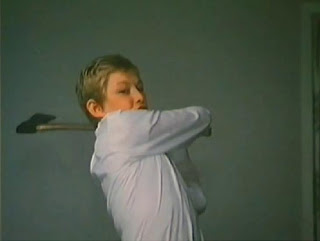... aka: Deadly Nightmares
... aka: Nightmare in a Damaged Brain
... aka: Nightmares in a Damaged Brain
... aka: Nightmares
... aka: Schizo
Directed by:
Romano Scavolini
Locked away in a New York state hospital for the criminally insane, George Tatum (Baird Stafford) suffers from paranoid schizophrenia, severe amnesia, homicidal dream fixations and seizures. Yes, he's quite fucked in the head. He's also the chief suspect in the sexual mutilation murders of an entire Brooklyn family, but doctors who've created new experimental drugs called "hylamene" and "TL54" think they can cure even him, or at least prevent him from being violent. George wakes up most nights screaming. He suffers from a recurring nightmare where are couple are chopped up with an axe, which turns out not to be just a nightmare, but a traumatic moment from his childhood buried deep inside his subconscious. Once George takes the newly prescribed pills, his bloody visions go away and thus, the doctors feel, so will his violent tendencies. They brand him their "first major success," release him back into the public, try to keep tabs on his whereabouts and hope they've indeed made the psychiatric breakthrough they were striving for. Nope.
All it takes is a visit to a 42nd Street XXX theater - which instantly bring to mind the childhood incident - to send George back to his murderous ways. On just his second day out of the hospital, he hops in his car and immediately flees the city. His destination: Daytona Beach, Florida, where his ex-wife Susan (Sharon Smith) and three kids live. George makes a pit stop in South Carolina to slash the throat of some woman he follows home from a bar and then steals her car. Upon arriving in the Sunshine State, he begins to silently stalk his former family - whom he abandoned almost a decade earlier - from the shadows, constantly calls them but won't say anything and even breaks into, and starts hiding out inside of, their home. He also takes time out of his busy schedule to murder a female jogger and a little kid, and will eventually kill others.
Nightmare has that same sleazy, grimy, nasty feel to it as William Lustig's MANIAC (1980) and John McNaughton's superior HENRY: PORTRAIT OF A SERIAL KILLER (1986), which I personally prefer to the more polished and bigger-budgeted slasher / serial killer films from this decade. Gore and violence-wise, it isn't really any worse than most others of its type. Regardless, it was trashed especially hard by critics, heavily-censored for an R-rating and even ended up on the notorious UK "Video Nasties" list. One man even went to prison for distributing this title. These incidents are not a result of the film being a bad example of its type, they're a result of the film actually being effective in its depictions of violence. I've never quite understood why critics are especially hard on these more serious-minded slasher films than they were on the lighter ones. If anything, showing violence for what it is and utilizing an appropriately depressing tone is far less "offensive" than some of the "slicker" mainstream slasher offerings, or even the Italian giallo, with their extended, colorful, flashy and fetishistic death scenes. The violence in Nightmare actually seems depressing and ugly, as it should.
The depiction of George's ex-wife and children also gives this another interesting edge. Instead of making Susan an innocent victim trying to move on with her life, she's actually a terrible, short-fused and selfish woman who neglects her children in favor of her new boyfriend (Mik Cribben). She certainly doesn't have time to be dealing with her troublesome youngest son C.J. (C.J. Cooke), who is showing early signs of having inherited some of his long-absent father's mental issues. C.J. likes to concoct morbid pranks (pretending to be an intruder, pretending like he's been attacked and stabbed, etc.) just to get his un-nurturing mother's attention. She spends most of her time screaming at the top of her lungs at him and tries to push C.J. and his two sisters off on her young babysitter Kathy (Danielle Ronen), who's about had it dealing with this woman's horribly-behaved children.
There isn't an overwhelming amount of gore on display, but what's here is well-done and even disturbing at times. The killer's flashback to his childhood - the nastiest sequence by far - finds young George walking in on his dad and his kinky mistress, who are in the middle of a bondage session. He grabs an axe, chops off the mistresses head and then sinks the axe right into his father's face. This sequence is shown in brief clips throughout the movie as George recalls them, but not in their entirety until the very end. Most prints have omitted many of the bloodier shots from this sequence. The "Uncut Special Edition" released through Infiniti Films in 2009 (what I viewed) runs 98 minutes and supposedly has all of the footage. Code Red put out a two-disc set containing interviews, commentary tracks and two different prints of the film in 2011.
Can't say it's all good news, though. The acting is pretty awful at times, the ending - where it takes at least six bullets to finally put the killer out of commission - is pretty ridiculous, there are some flagrantly stupid moments - like the babysitter mistaking the fully grown psycho as her nine-year-old charge just because he's wearing a mask - and the whole experimental drug angle isn't elaborated upon enough to make it all that interesting. The result: This is pretty much just slice-and-dice business as usual, though somewhat better than usual, nonetheless.
The production manager was Simon Nuchtern, who'd go to direct his own slasher: Silent Madness (1984). On some advertising materials, Tom Savini was erroneously credited as having done the special makeup effects. He didn't (though he did advise Ed French), and promptly sued to halt them from continuing to use his name in their publicity.
★★1/2


























